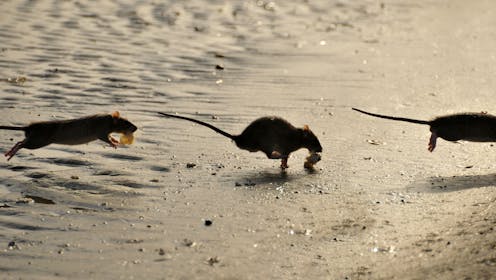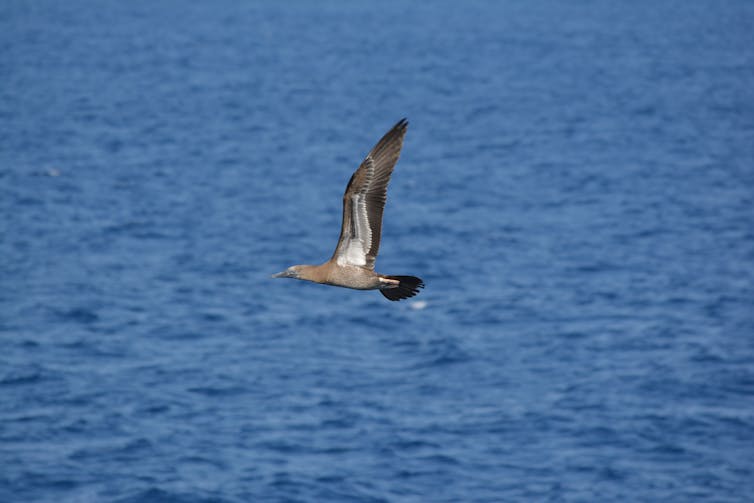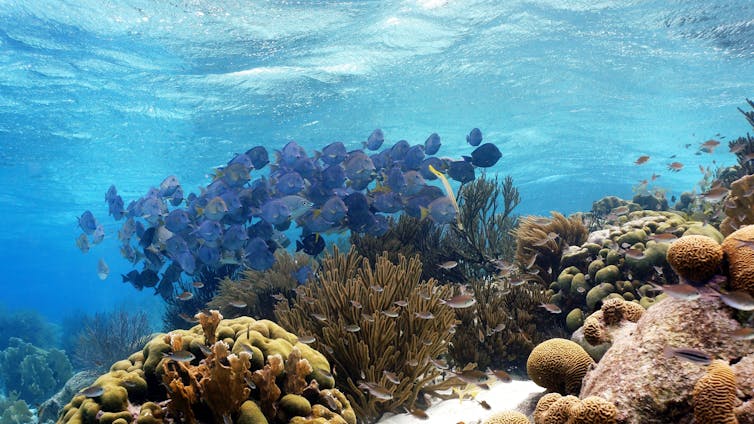
Coral reefs are degrading rapidly to the extent that their marine inhabitants must either adapt or die. For many animals, including reef fish, behaviour is one of the first responses to changes in environmental conditions.
Behavioural changes may be critical for predicting the future survival of many animal species. This is encouraging marine scientists to study how, why or when these changes happen.
Much of the existing research into the impact of environmental change on reef fish species tends to focus on increasing sea temperatures and ocean acidification. But some coral reef ecosystems are also threatened by one, more surprising source. An invasive species – the black rat – has overrun many islands in the Chagos Archipelago, a remote group of small islands in the Indian Ocean. The rats are altering the functioning of surrounding marine ecosystems.
Recent research that we co-authored alongside colleagues from Lakehead University in Canada revealed that these rats are affecting the territorial behaviour of fish by reducing the flow of nutrients from bird droppings into the ocean.
We focused on the jewel damselfish, a small fish that aggressively defends patches of edible algae it cultivates through a process known as “farming”. Our research surveyed coral reefs both around islands with high seabird densities and without rats, and islands with low seabird densities and many rats. Jewel damselfish in the seas surrounding rat-infested islands were less aggressive and defended larger territories than those surrounding rat-free islands.
Invasive rats
The rats, many of which arrived on the Chagos Archipelago on ships in the 18th century, prey on small seabirds and their eggs. This has decimated seabird populations on these islands. Seabird densities are up to 760 times smaller on rat-infested islands than on islands without rats.
But seabirds are a key component of the nutrient cycle. They feed in the ocean and return to the islands to roost and breed where they deposit large quantities of droppings. Their droppings, which are rich in nutrients, are then washed into the sea and onto nearby coral reefs.
By supplementing coral reefs with additional natural nutrients, seabirds are able to fertilise these ecosystems. Rat predation has disrupted this cycle and removed the nutrients provided by seabirds to coral ecosystems.

Aggressive economics
We found that algae in jewel damselfish territories next to rat-free islands were richer in nutrients than in territories next to rat-infested islands. However, the total amount of algae within the territories was unaffected.
This means that the quality, but not the quantity, of the food resources available to the jewel damselfish is higher in the waters surrounding rat-free islands. The fish in these territories get “more for their money” when foraging. The quality of nutrients means that fish are able to find all the food they need in smaller territories than fish around rat-infested islands.
But this carries behavioural consequences. We found that jewel damselfish in reefs surrounding rat-free islands were five times more likely to be more aggressive and 70 times more likely to hold smaller territories than those next to rat-infested islands.
The additional nutrients from seabird droppings in seas around islands with large seabird populations raise the quality of jewel damselfish territories and make them worth defending. The quality of nutrients in these locations means that the nutritional benefits of defending a territory are higher than the energy costs expended by aggressively defending them.
This is not the case for jewel damselfish in seas around rat-infested islands. The disruption to the nutrient cycle here results in lower quality territories that are less worth defending.
Small fish, big impact
By disrupting the nutrient cycle, invasive rats have directly reduced the aggressive tendencies of damselfish. But this behavioural change may alter the wider coral ecosystem.
The social organisation of blue tangs, a fish native to coral reefs in the Indo-Pacific, can be influenced by the territoriality of farming damselfish. Tangs tend to form schools in areas of the reef with high densities of territorial damselfish. This is likely because it allows “safety in numbers” when accessing defended algae and increases competition for algal food resources. But research has found that where damselfish densities are low, tangs rarely form schools.

Algal productivity (grams of biomass per square metre) can also be affected by territorial damselfish. Algae within farming damselfish territories can, for example, be up to 3.4 times more productive than algae growing outside of the territories.
Territorial damselfish can also impact the density of coral within an area and therefore the structure of a reef. In Kenya, research has shown that the density of juvenile coral is lower inside farming damselfish territories than that in non-defended areas. Invasive rats may therefore affect coral replenishment and the functioning of the wider ecosystem.
By establishing the link between fish behaviour and the seabird nutrient cycle, our study highlights the potential for rat eradication to restore territorial fish behaviour. Measures to eradicate invasive rats from tropical islands have slowly been introduced across the Indian Ocean over the past 16 years. Evidence suggests that these measures have contributed to the return of seabird nutrients to tropical islands and coral reefs.
Animal behaviour is an important but understudied aspect of biological research into ecological responses to environmental change and should be a focal point for future studies.
Sally Keith receives funding from NERC.
This research was supported by the Natural Environment Research Council (Rachel L. Gunn, grant number NE/L002604/1), with Rachel L. Gunns studentship through the Envision Doctoral Training Partnership.
This article was originally published on The Conversation. Read the original article.







